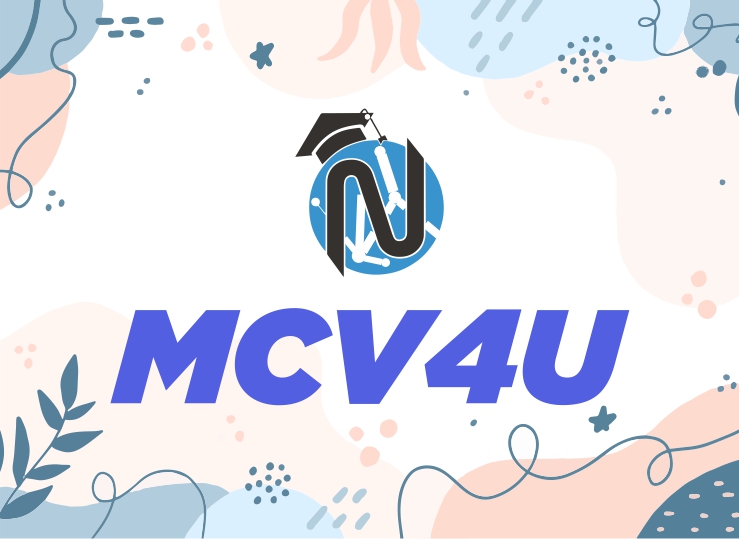
Calculus and Vectors (MCV4U)
Course Description
This course builds on students’ previous experience with functions and their developing understanding of rates of change. Students will solve problems involving geometric and algebraic representation of vectors and representations of lines and planes in three-dimensional space; broaden their understanding of rates of change to include the derivatives of polynomial, sinusoidal, exponential, rational, and radical functions; and apply these concepts and skills to modelling of real-world relationships, Students will also refine their use of mathematical processes necessary for success in senior mathematics. This course is intended for students who choose to pursue careers in fields such as science, engineering, economics, and some areas of business, including those students who will be required to take a university level calculus, linear algebra, or physics course.
For Ministry Guideline Click Here
| Units | Descriptions | Length (Approximately) |
|---|---|---|
| 1. | Rate of Change A variety of mathematical operations with functions are needed in order to do the calculus of this course. This unit begins with students developing a better understanding of these essential concepts. Students will then deal with rates of change problems and the limit concept. While the concept of a limit involves getting close to a value but never getting to the value, often the limit of a function can be determined by substituting the value of interest for the variable in the function. Students will work with several examples of this concept. The indeterminate form of a limit involving factoring, rationalization, change of variables and one-sided limits are all included in the exercises undertaken next in this unit. To further investigate the concept of a limit, the unit briefly looks at the relationship between a secant line and a tangent line to a curve. To this point in the course students have been given a fixed point and have been asked to find the tangent slope at that value, in this section of the unit students will determine a tangent slope function like what they had done with a secant slope function. Sketching the graph of a derivative function is the final skill and topic. |
20 hours |
| 2. | Derivatives Derivatives The concept of a derivative is, in essence, a way of creating a short cut to determine the tangent line slope function that would normally require the concept of a limit. Once patterns are seen from the evaluation of limits, rules can be established to simplify what must be done to determine this slope function. This unit begins by examining those rules including: the power rule, the product rule, the quotient rule and the chain rule followed by a study of the derivatives of composite functions. The next section is dedicated to finding the derivative of relations that cannot be written explicitly in terms of one variable. Next students will simply apply the rules they have already developed to find higher order derivatives. As students saw earlier, if given a position function, they can find the associated velocity function by determining the derivative of the position function. They can also take the second derivative of the position function and create a rate of change of velocity function that is more commonly referred to as the acceleration function which is where this unit ends. |
20 hours |
| 3. | Derivative Applications and Related Rates A variety of types of problems exist in this unit and are generally grouped into the following categories: Pythagorean Theorem Problems (these include ladder and intersection problems), Volume Problems (these usually involve a 3-D shape being filled or emptied), Trough Problems, Shadow problems and General Rate Problems. During this unit students will look at each of these types of problems individually. |
15 hours |
| 4. | Curve Sketching In previous math courses, functions were graphed by developing a table of values and smooth sketching between the values generated. This technique often hides key detail of the graph and produces a dramatically incorrect picture of the function. These missing pieces of the puzzle can be found by the techniques of calculus learned thus far in this course. The key features of a properly sketched curve are all reviewed separately before putting them all together into a full sketch of a curve. |
15 hours |
| 5. | Vectors There are four main topics pursued in this initial unit of the course. These topics are an introduction to vectors and scalars, vector properties, vector operations and plane figure properties. Students will tell the difference between a scalar and vector quantity, they will represent vectors as directed line segments and perform the operations of addition, subtraction, and scalar multiplication on geometric vectors with and without dynamic geometry software. Students will conclude the first half of the unit by proving some properties of plane figures, using vector methods and by modeling and solving problems involving force and velocity. Next students learn to represent vectors as directed line segments and to perform the operations of addition, subtraction, and scalar multiplication on geometric vectors with and without dynamic geometry software. The final topic involves students in proving some properties of plane figures using vector methods. |
15 hours |
| 6. | Vector Applications Applications involving work and torque are used to introduce and lend context to the dot and cross products of Cartesian vectors. The vector and scalar projections of Cartesian vectors are written in terms of the dot product. The properties of vector products are investigated and proven. These vector products will be revisited to predict characteristics of the solutions of systems of lines and planes in the intersections of lines and planes. |
15 hours |
| The final assessment task is to provide students to do Exam Review (4 Hrs) +Formative Exam (2 Hrs) +Culminating Task (2 Hrs) + Final Exam (2 Hrs) | 10 hours | |
| Total | 110 hours | |
Overall Curriculum Expectations
By the end of this course, students will:
- demonstrate an understanding of rate of change by making connections between average rate of change over an interval and instantaneous rate of change at a point, using the slopes of secants and tangents and the concept of the limit.
- graph the derivatives of polynomial, sinusoidal, and exponential functions, and make connections between the numeric, graphical, and algebraic representations of a function and its derivative.
- verify graphically and algebraically the rules for determining derivatives; apply these rules to determine the derivatives of polynomial, sinusoidal, exponential, rational, and radical functions, and simple combinations of functions; and solve related problems
By the end of this course, students will:
- make connections, graphically and algebraically, between the key features of a function and its first and second derivatives and use the connections in curve sketching.
- solve problems, including optimization problems, that require the use of the concepts and procedures associated with the derivative, including problems arising from real-world applications and involving the development of mathematical models.
By the end of this course, students will:
- demonstrate an understanding of vectors in two-space and three-space by representing them algebraically and geometrically and by recognizing their applications
- perform operations on vectors in two-space and three-space and use the properties of these operations to solve problems, including those arising from real-world applications.
- distinguish between the geometric representations of a single linear equation or a system of two linear equations in two-space and three-space and determine different geometric configurations of lines and planes in three-space
- represent lines and planes using scalar, vector, and parametric equations, and solve problems involving distances and intersections.
Assessment & Evaluation of student performance
Formative assessments are learning practices that provide important feedback to student progress. Examples include homework and quizzes.
Summative assessments form a foundation for final mark allotment at the end of the unit, term and final evaluation.
An achievement chart will be given to students at regular intervals and the purpose of the charts is to provide feedback to students in relation to content and performance strands.
| Knowledge and understanding | Communication | Thinking Inquiry and Problem solving | Application |
|---|---|---|---|
| 25% | 25% | 25% | 25% |
Unit Tests, Written assignments, presentations, Classroom Observations and Classroom conversations.










